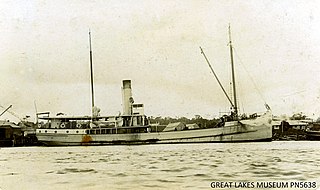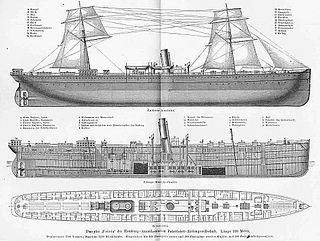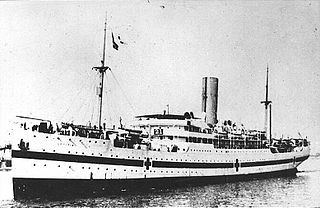
SS Ceramic was a steam ocean liner built in Belfast for White Star Line in 1912–13 and operated on the Liverpool – Australia route. Ceramic was the largest ship serving the route until P&O introduced RMS Mooltan in 1923.

The Fitzroy was a steel-hulled steamship built in 1912 at Old Kilpatrick, Scotland in 1912. Thirty-one people were killed when Fitzroy capsized in a gale whilst carrying a general cargo between Coffs Harbour and Sydney off Cape Hawke, New South Wales on 26 June 1921.

The Comboyne was a wooden screw steamer built in 1911 at Tuncurry, that was wrecked when it struck an object whilst carrying timber to Wollongong and was lost at approximately 1 mile (1.6 km) off Bass Point, Shellharbour, New South Wales on 27 November 1920.

The Koonya was a wood carvel screw steamer built in 1887 at Hobart, that was wrecked when it stuck the shore at Doboy reef whilst carrying passengers & cargo between Moruya and Sydney and was lost off Cronulla Beach, Port Hacking, New South Wales on 25 January 1898.
SS Bonnie Dundee was a 193/121 Gross register tons Australian steamship which sank after a collision with the steamship SS Barrabool off Lake Macquarie, New South Wales, Australia, on 10 March 1879.

The SS Silesia was a late 19th-century Hamburg America Line passenger and cargo ship that ran between the European ports of Hamburg, Germany and Le Havre, France to Castle Garden and later Ellis Island, New York transporting European immigrants, primarily Russian, Prussian, Hungarian, German, Austrian, Italian, and Danish individuals and families. Most passengers on this route were manual laborers, including stonecutters, locksmiths, farmers, millers, upholsterers, confectioners, and tailors, though physicians and other professionals also bought passage on her.

HMAS Koolonga was a 4,260 gross register tons cargo ship built by Sunderland Shipbuilding Company, South Dock Sunderland, England, in 1914 and bought by McIlwraith, McEacharn Line Pty Ltd, Melbourne and named SS Koolonga. She was requisitioned by the Royal Australian Navy on 6 August 1914, as a collier and supply ship. She was returned to her owners in late 1915. She was sold in 1937 to Madrigal & Company, Philippines and renamed Paz. She was sunk during the Second World War at Manila Bay in December 1941 and was later salvaged by the Imperial Japanese and renamed Hatsu Maru. While at anchor in Manila Bay, Philippines on 13 November 1944, she was attacked by United States Navy carrier aircraft and was sunk.

Nyon was a 5,364 GRT cargo ship that was built in 1952. She ran aground in 1958, and was cut in two in order to salvage her. The stern section was salvaged and a new bow section built and fitted in 1959. She served until 1962 when she was involved in a collision with another ship and sank.

SS (RMS) Douglas (III) – the third vessel in the line's history to bear the name – was a packet steamer which entered service with the London and South Western Railway in 1889 under the name Dora until she was purchased by the Isle of Man Steam Packet Company in 1901 for £13,500.
HMAS Waree (W128) was a tug boat operated by the Royal Australian Navy (RAN) during World War II. She operated as a tug boat for the Waratah Tug and Salvage Company before being requisitioned by the RAN in 1942, and operating in northern Australia and Papua. She sank on 17 October 1946 off the New South Wales coast while sailing to Sydney from Thursday Island.

The Nimbin was a steel screw steamer built in 1927 at Copenhagen, that was the first motor vessel placed into the New South Wales coastal trade. It was owned and operated by the North Coast Steam Navigation Company and was the first Australian registered merchant ship to be lost during World War II when it struck a mine laid by the German auxiliary cruiser Pinguin. The Nimbin was on its way from Coffs Harbour to its home port, Sydney, with a cargo of bundled three-ply timber and a cargo of pigs. One third of the ship was blown away and it sank in three minutes. Seven men were killed. The remaining thirteen clung to bundles of plywood. Some hours later an air force plane from RAAF Base Rathmines saw the survivors and directed the coastal ship SS Bonalbo to the scene to retrieve them.

SS Oceana was a P&O passenger liner and cargo vessel, launched in 1887 by Harland and Wolff of Belfast and completed in 1888. Originally assigned to carry passengers and mail between London and Australia, she was later assigned to routes between London and British India. On 16 March 1912 the ship collided in the Strait of Dover with the Pisagua, a 2,850 GRT German-registered four-masted steel-hulled barque. As a result Oceana sank off Beachy Head on the East Sussex coast, with the loss of 17 lives.
SS Oakland was a small general cargo/passenger ship commissioned in 1890, Dumbarton, Scotland, for New South Wales, Australia, timber merchant William T Yeager. It sank off Cabbage Tree Island, New South Wales, in 1903, with the loss of 11 lives.

HMHS Letitia was a British hospital ship that ran aground at Portuguese Cove in Halifax Harbour, Canada on 1 August 1917 while carrying 546 wounded Canadian soldiers from Liverpool, United Kingdom to Halifax, Nova Scotia, Canada.
Helsingfors was a Finnish freight and passenger steamship built in Belgium in 1903 for Helsingfors Ångfartygs Aktiebolaget. She ran aground and sank near Bengtskär on 1 January 1905. The accident resulted in the construction of the Bengtskär Lighthouse.

Long Reef is a prominent headland on the Northern Beaches of Sydney, Australia. Connected to the mainland by a tombolo, the reef has an extensive wave-cut platform. Long Reef is a popular recreational destination and is one of the more interesting geological areas in Sydney.

Sixty-miler (60-miler) is the colloquial name for the ships that were used in the coastal coal trade of New South Wales, Australia. The sixty-milers delivered coal to Sydney Harbour from ports and ocean jetties to the north and south of Sydney. The name refers to the approximate distance by sea—actually 64 nautical miles—from the Hunter River mouth at Nobbys to the North Head of Sydney Harbour.

Langton Grange was a refrigerated steam cargo ship built in 1896 by the Workman, Clark & Co. of Belfast for Houlder Brothers & Co. of London to transport meat and other produce from Australia and South America to United Kingdom.

SS Bayardo was a British refrigerated cargo ship that ran aground and was wrecked on the Middle Sand in the Humber Estuary, near Hull, United Kingdom on 21 January 1912 while she was travelling from Gothenburg, Sweden to Hull, United Kingdom carrying general cargo.

Rock Davis (1833-1904) was a shipbuilder, mainly associated with his shipyard, the Rock Davis shipyard, colloquially known as 'the Big Shed', on Brisbane Water at Blackwall, New South Wales, Australia. After his death, the business of ship building was carried on by his second son, also Rock Davis. The shipyard constructed around 165 wooden-hulled vessels, between 1862 and 1913.
















